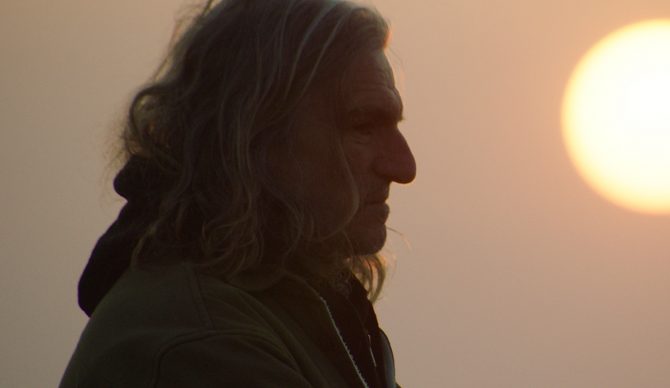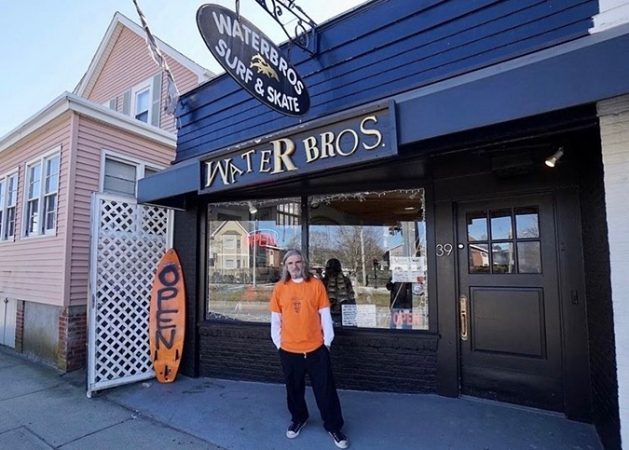“Core” is a word thrown around in surfing, some may argue, too often. “Those glasses are so core,” “wearing a black wetsuit is core,” “Huntington Beach is core.” Strangely, it can feel like the word “core” has lost its, well, initial direction.
The Inertia’s Alex Haro argues that the word “core” relates to one being central and foundational to surfing. If we were to use this as the standing definition, no one, then, is more core than Sid Abbruzzi.
Sid, “The Package,” is now 72 years old. He’s not only lived through, but greatly influenced, the surf and skate community when it was first finding its footing in Newport, Rhode Island. Skate legend Tony Hawk not only praised his East Coast skate park, but included it in his video game. Sid traveled out West to surf Steamer Lane, and in traditional Sid fashion, was welcomed in like a local by icons of surfing Darryl “Flea” Virostko and Pete Mel.
Water Brothers: The Sid Abbruzzi Story, woven together by the Kinnane brothers (who also produced Home Team, starring Kevin James), documents Sid’s story with footage from never-before-seen archival film, large format cinematic footage, and personal interviews from the likes of Christian Fletcher, Shepard Fairey, and Selema Masekela. In the process, Water Brothers also provides a window into the eras we now look back on with a tinge of jealousy.
While Sid’s impact on surfing and skating is one many people may not know, surfers and skaters quietly benefit from his fearlessness and generosity every day. This film captures the emotional story of Sid’s iconic Water Brothers Surf & Skate shop as it is set to be demolished.
This documentary recently premiered at 2023 NewportFILM, where it broke the ticketing system due to the interest it received from the community. Now, the Godfather of East Coast surfing’s story is being screened to the delight of rowdy crowds — and history enthusiasts — everywhere.
I sat down with Sid to chat about making the documentary and what’s next for its tour.

The man is a certified legend. Photo: Water Brother
What was the process like gathering all of the footage for the documentary?
I grew up with the filmmakers (the Kinnane brothers). I grew up surfing with their dad and I sold ’em their first surfboards and then they became the Canadian brother film company. I have known them since they were three or four years old. Around 10 or 12, Chuck, the oldest brother, had a camera and he was filming all the surfing in his area. Cool stuff like that.”
In the seventies, we started shooting with super-eight, Hi-8, VHS, all these formats. Somehow, I held onto all that stuff and documented traveling in Santa Cruz, South Africa, all those spots. People gave us film and we ended up with about two miles of vintage footage. We were very fortunate that about 45 minutes from us was one of the best processing facilities in the world. We were able to get all that old stuff cleaned up and on 4K. They did a bang-up job.
There was so much footage I had. I almost wish we could have used more. We had it put on different formats and occasionally we’d watch it ourselves before any of the documentary work. I was familiar with it, but I really enjoyed the South Africa stuff. I really enjoyed the Santa Cruz stuff.
Were there any parts or people in the film that made you especially nostalgic?
Pete [Mel] has been a friend of mine for 20, 30 years. We shot in Santa Cruz for about three weeks in November. It was the Coldwater Classic. It was the first one they ran in seven years. So that’s where Anthony Ruffo and Pete Mel were and Balaram, too, for that one. I wish we could have gotten everybody in, but there was too much footage.
I met Derek Hynd in 1990. As part of the search, I was living in Jeffrey’s Bay and Derek had his house next to Mike Tabling. I had known Derek before, but then we became best friends. I’m in touch with him once or twice a week. We sent a film crew out to Australia, a number of camera crews, but something happened with the footage where the guys didn’t think it was up to snuff with the sound or something. The biggest bummer in the world was not having my friend Derek in the movie. I wouldn’t change a thing with the movie, you know, but some parts you wish some of the guys were in. Chuck, the director, is one of my best friends. I’ve known him since he was a baby. He said, “Sid, listen, it’s best not even to interview some of these guys because we can’t put them all in the movie.”
Do you ever look around Rhode Island now and feel emotions at how things are now versus back when you’d just opened the shop and things were just getting started?
I’ve always been proud of being from Rhode Island even from the seventies. I remember when I first went to Santa Cruz and to Cocoa Beach, Florida, it was like, “is Rhode Island a part of New York?” They actually thought that. I said, “no, we’re actually a state.” People accepted me into their community, whether it be the West side guys or the guys down in Sebastian Inlet… it was a tight-knit group of people. They opened the door for me because I was from Rhode Island. If I was from San Diego, down the street, they would’ve slammed the door in my face. But because Rhode Island’s such a small and unique place, it really worked out that way.

Sid, in front of the famed shop front. Photo: Water Brother
Was there a message in this movie?
There wasn’t really a target. We weren’t trying to target a sobriety thing or a party thing or a wave thing. We just made the movie and let the chips fall where they fell. It’s up and down and it’s an emotional rollercoaster. One kid saw it and said it’s more emotional than Lion King, (laughs). We didn’t have anyone in mind except people to enjoy the film and reminisce on some of the way things used to be in a way.
What is happening with the documentary now?
We’re very fortunate, we’re playing seven nights at the Angelica Theater in New York City in Soho July 26th to August 1st. We’re looking forward to that. I’m 72, 73 in August. Traveling to Africa these days has slowed down, for sure. But we’re looking forward to reconnecting with everybody. We have a pretty good schedule. In the fall, we’ll be in California, from San Diego all the way up north of San Francisco. We hope to be in Hawaii in January, and Portugal and Europe and Ireland in February and March.

